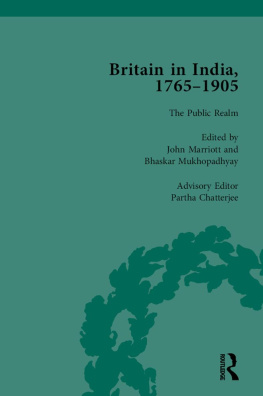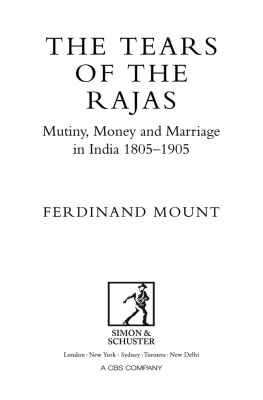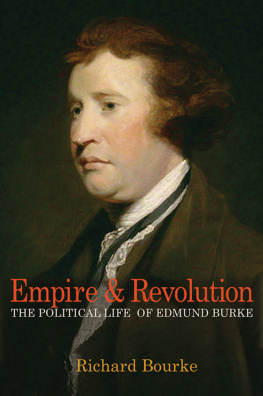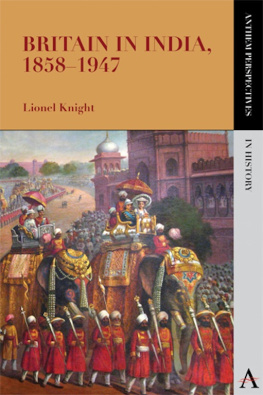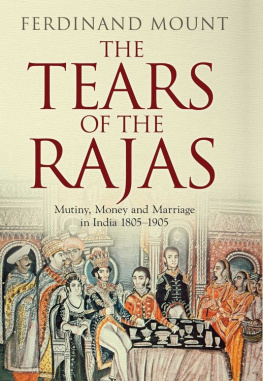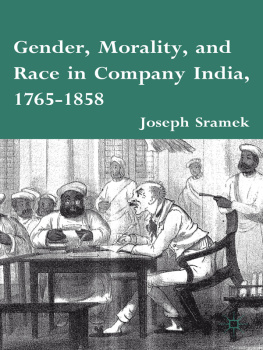First published 2006 by Pickering & Chatto (Publishers) Limited
Published 2016 by Routledge
2 Park Square, Milton Park, Abingdon, Oxon OX14 4RN
711 Third Avenue, New York, NY 10017, USA
Routledge is an imprint of the Taylor & Francis Group, an informa business
Taylor & Francis 2006
Editorial material John Marriott and Bhaskar Mukhopadhyay 2006
All rights reserved, including those of translation into foreign languages. No part of this book may be reprinted or reproduced or utilised in any form or by any electronic, mechanical, or other means, now known or hereafter invented, including photocopying and recording, or in any information storage or retrieval system, without permission in writing from the publishers.
Notice:
Product or corporate names may be trademarks or registered trademarks, and are used only for identification and explanation without intent to infringe.
BRITISH LIBRARY CATALOGUING IN PUBLICATION DATA
Britain in India, 17651905
1. British India History Sources 2. India History British occupation, 17651947 Sources
I. Marriott, John, 1944 II. Mukhopadhyaya, Bhaskara III. Chatterjee, Partha, 1947
954.03
ISBN-13: 978-1-85196-815-2 (set)
Typeset by P&C
FAMINE AND PUBLIC HEALTH
This volume gathers material on the various public initiatives taken by the East India Company and the colonial state in response to social and economic problems perceived to demand attention.1 Although wide-ranging in scope, the expenditures involved had in common the aim of reducing the toll on human life exacted by disease and famine, and/or raising additional revenue through greater efficiency.
In 1765 the East India Company acquired the Diwani of the Presidency of Bengal. This conferred the right to collect revenue from the extensive tracts of land that made up not only present day Bengal but also Orissa and Bihar. Preoccupied with maximizing revenue from the acquisition of a system of land ownership, administration, rights and duties that few officials were capable of understanding, and oblivious to the necessities or desirability of public expenditure, the Company relinquished virtually all of its responsibilities. At no time was this better illustrated than during the famine of 1770.
The famine claimed between one sixth and one third of the population of Bengal.2 Faced with a calamity on this scale it was hardly surprising that inexperienced Company officials were ineffectual in their response. More difficult to explain is the callous exploitation of the situation in pursuit of gain. Despite alarming reports from the various districts, the governing Council was slow to acknowledge the extent of the disaster. Temporary remissions in the payment of land tax were proposed where hardship could be proven, although in practice few were granted.3 In the hope of making best use of depleted resources, proclamations were issued against the hoarding and exportation of grain. Even public relief was offered. But all these measures were wholly inadequate. Throughout the famine the Company contributed 9,000 to relieve the sufferings of some thirty million starving people. This was augmented by 4,700 from indigenous subscriptions. 15,000 was spent on imported grain, which was then sold at a profit of nearly 7,000. It was a scene, in the words of Hunter, of corruption and heartlessness which raises suspicions as to whether the pittance nominally granted by Government ever reached the sufferers.4 Indeed, rumours abounded at the time that many officials were profiteering in the grain trade.
Under Mughal rule communication and irrigation works were undertaken to ameliorate scarcity by facilitating the supply of grain to remote regions and by improving the fertility of the soil. As Mughal power declined so these systems deteriorated and fell into disuse. The British showed little interest in providing public funds to restore them; instead the famine provided them with conclusive evidence that the administration of land required radical overhaul. Hope was thus invested in the Permanent Settlement as the means to improvement.5 Further famines followed. In 17812 famine struck Madras, and in 17834 another, noted by some as the worst in living memory, descended on the North-West Provinces.
The Company decided that something had to be done. Having considered plans of the Governor-General, Cornwallis, to guard against the frequent return of calamities which have been so often experienced in Bengal from the scarcity of grain, the Court of Directors recommended just prior to the introduction of the Permanent Settlement that they be adopted in Madras.6 The plans were to establish public granaries in which to store grain in plentiful years which could be then be sold during times of scarcity, so combating price rises and profiteering. The plans would be overseen by the Grain Department, set up in 1794, which would continue to seek further information. Following reports from district collectors it was recommended that granaries be located in the principal villages rather than centrally. This, the Board of Revenue argued, using a rhetoric redolent of the English Poor Law, was more eligible as it enabled the inhabitants to remain in their villages and exert their industry instead of assembling in multitudes at one spot which would prevent a possibility of their assisting themselves by their own labour.7
The plans, however, were short lived. Further inquiries heightened anxieties not only that granaries would encourage that indolence so predominant in the character of the natives of this country, but also that public storage of grain would constitute an impolitic interference in the trade of grain and the speculations of merchants.8 It was also apparent by then that the costs of transport, storage and protection of the grain against damage and loss were prohibitive. In August 1797 the Governor-General confessed the enormous expense of the project to the Board of Revenue and submitted the results of the inquiries to the court.9 In 1801 the plans were abandoned.
The urban environments of eighteenth-century Bengal may have presented different problems, but the same neglect prevailed. Founded by Job Charnock, a Company agent, in the late seventeenth century, Calcutta rapidly emerged as a site of some importance. British factors and merchants, however, remained under the authority of Indian government. Municipal administration was entrusted to the zamindar, who controlled executive and revenue business by collecting ground rents and town duties, and had responsibility for civil and criminal jurisdiction over indigenous residents.10 Located in a malarial swamp adjacent to a pestilential jungle, the town was constantly at risk from disease, but few attempts were made to improve its conditions. While the zamindar had formal authority for repairs to roads and drains, resources made available were totally inadequate.
With the continued growth of the town came recognition of the need for administrative reform. In 1726 British authorities were granted a Charter of Incorporation, allowing the establishment of a Mayors Court and Justices of the Peace, thus laying the foundations for judicial administration based on English practice. Judicial authority was strengthened by the 1753 Charter, which conferred the power to enact by-laws, but in other respects little changed in the administration of municipal affairs. In the meantime the population of Calcutta continued to increase and with it the incidence of disease. For some this state of affairs was an indictment of British rule in India. William Mackintosh singled out his visit to Calcutta during his extensive travels over three continents during the 1770s. There was, he declared, not a place


